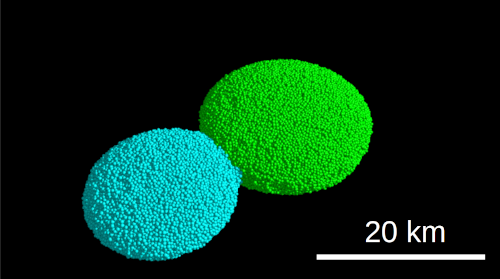- 1University of Maryland, Astronomy, United States of America (jmarohni@umd.edu)
- 2University of Maryland, Astronomy, United States of America
- 3Johns Hopkins University, Applied Physics Laboratory, United States of America
- 4Washington University in St. Louis, Department of Earth and Planetary Sciences and McDonnell Center for the Space Sciences, United States of America
- 5Southwest Research Institute, United States of America
In 2019, the New Horizons spacecraft flew by the Kuiper belt object (486958) Arrokoth, a member of the cold classical population in the Kuiper belt. Images returned from the New Horizons flyby reveal that Arrokoth is a contact binary composed of two distinct lobes joined by a narrow contact region (the "neck"). The lobes are roughly similar to oblate spheroids in shape and the long axis of the whole body is about 35 km long [1]. Cold classical Kuiper belt objects like Arrokoth are thought be among the most primitive bodies in our solar system, forming in their current positions from the solar nebula over 4 Gyr ago and remaining nearly undisturbed since. The mechanism by which Arrokoth formed is thus of great interest and may lend unique insight into the formation of terrestrial bodies in the outer solar system. Under the assumption that Arrokoth is the union of two distinct progenitor bodies, we use a numerical code to model the final stage of the merger that created this unique object. We investigate a range of possible merger parameters and use the results to determine the most plausible scenarios. We describe the methods we used to simulate the merger and detail our results. The work presented here is described in greater detail in Marohnic et al. 2020, in press for the Icarus special issue on Kuiper belt science [2].
We use the parallel N-body code 'pkdgrav' to model the Arrokoth merger [3]. pkdgrav uses the soft-sphere discrete element method (SSDEM) to compute collisions between spherical particles. SSDEM resolves contacts by allowing particles in contact to interpenetrate slightly as a proxy for deformation. Restoring forces are modeled as damped springs and static, rolling, and twisting friction are accounted for as well. Both lobes are modeled separately, as "rubble piles" composed of spherical particles. In total, each simulated merger event uses between 100,000 and 200,000 particles. Our simulations test the effects of varying impact angle and speed, material cohesion strength, body shape, bulk density, and spin (see Figure 1).

Figure 1: A gentle contact between two rubble-pile bodies formerly in a close, synchronous orbit. The shape of the progenitor bodies are preserved, and the neck-like contact area remains narrow and well-defined.
The results of our suite of simulations suggest that any merger that could produce an object like Arrokoth would have to have been quite slow (roughly equal to the mutual escape speed of the progenitor objects or slower) and at a near-grazing angle. We find that the most plausible scenario is a gradual inspiral of two bodies in a close synchronous orbit leading to final, gentle merger.
Acknowledgements: The simulations described here were performed on the Deepthought 2 cluster at the University of Maryland, College Park. This work was supported by NASA grant NNX15AH90G awarded by the Solar System Workings program, by a University of Maryland Graduate School Research and Scholarship Award, and by NASA's New Horizons project via contracts NASW-02008 and NAS5-97271/TaskOrder30.
[1]: Stern, S.A., Weaver, H.A., Spencer, J.R., Olkin, C.B., Gladstone, G.R., Grundy, W.M., Moore, J.M., Cruikshank, D.P., Elliott, H.A., McKinnon, W.B. and Parker, J.W., 2019. Initial results from the New Horizons exploration of 2014 MU69, a small Kuiper Belt object. Science, 364(6441).
[2]: Marohnic, J.C., Richardson, D.C., McKinnon, W.B., Agrusa, H.F., DeMartini, J.V., Cheng, A.F., Stern, S.A., Olkin, C.B., Weaver, H.A. and Spencer, J.R., 2020. Constraining the final merger of contact binary (486958) Arrokoth with soft-sphere discrete element simulations. Icarus, p.113824.
[3]: Stadel, J.G., 2001. Cosmological N-body simulations and their analysis (Doctoral dissertation, University of Washington).
How to cite: Marohnic, J. C., Richardson, D. C., McKinnon, W. B., Agrusa, H. F., DeMartini, J. V., Cheng, A. F., Stern, S. A., Olkin, C. B., Weaver, H. A., and Spencer, J. R.: Constraining the final merger of contact binary (486958) Arrokoth with soft-sphere discrete element simulations, Europlanet Science Congress 2020, online, 21 Sep–9 Oct 2020, EPSC2020-378, https://doi.org/10.5194/epsc2020-378, 2020.

